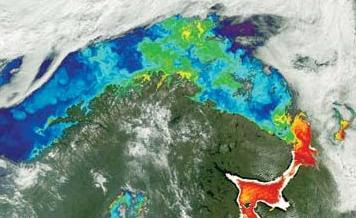 A venture to profit from a CO2-eating algae bloom riles scientists:
A venture to profit from a CO2-eating algae bloom riles scientists:Researchers have debated for a long time whether dumping iron into the ocean could ameliorate climate change. Iron encourages the bloom of tiny algae called phytoplankton, which take in carbon dioxide (CO2) dissolved in the ocean for photosynthesis; that process in turn draws atmospheric CO2 into the surface waters. Most scientists remain skeptical of whether iron fertilization will lead to greater carbon sequestration. But a company called Planktos, based in Foster City, Calif., has been forging ahead with such plans. Its latest target: 10,000 square kilometers of the equatorial Pacific, 600 kilometers west of the Galápagos—by far the most ambitious and controversial iron-seeding plan yet.
Phytoplankton photosynthesize as much CO2 as all the terrestrial plants combined. Although most of the fixed carbon returns to the ocean within a week when the phytoplankton die, perhaps up to a fifth of the biomass sinks to deeper waters, trapping carbon in the sea. For photo-synthesis, phytoplankton need trace amounts of iron, and in the equatorial Pacific, the metal primarily comes from dust storms in the Gobi and Taklimakan deserts of Central Asia.
Citing a 2003 study by NASA and the National Oceanic and Atmospheric Ad-ministration (NOAA), Planktos claims that the amount of iron entering the equatorial Pacific has decreased by 15 percent since the early 1980s—presumably because of shifting wind patterns and fewer dust storms. As a result, the firm infers, phytoplankton populations there have decreased by 6 percent and CO2 absorption by 3 percent. Through iron fertilization, Planktos wants to restore iron and phytoplankton to pre-1980 levels, which “will absorb 70 per-cent of the world’s current CO2 emission,” affirms Planktos marketing chief William Coleman.
Dalhousie University oceanographer John Cullen, however, does not think that a low phytoplankton level necessarily indicates less carbon sequestration. A “successful” fertilization, he explains, will sink phytoplankton bio-mass—along with the nutrients it absorbs—to deeper waters, depleting the surface of chlorophyll (phytoplankton) and iron. Such declines might therefore be a signature of carbon being sequestered.
In any case, most investigators doubt that adding iron will shift the carbon load to the oceans. A dozen experiments have indeed shown that extra iron results in phytoplankton blooms, but whether carbon becomes trapped in the deep ocean over the long run remains unknown. In one such experiment, “less than 10 percent of the extra carbon that was fixed was actually making it to even 120 meters” of depth, says oceanographer Philip Boyd of the National Institute of Water and Atmospheric Research in New Zealand. And strong upwellings in the equatorial Pacific would probably release the trapped carbon back into the atmosphere in a few years anyway, says University of Southern California oceanographer Anthony Michaels.
Other data also counter
Planktos’s position that less iron has been blowing in from Asia. Air-sample analysis at Midway Island—the only station in the Pacific collecting in situ data on dust transport—“has not shown any declining trend [in Asian dust] from
1981 to 2001,” says the University of Miami’s Joseph Prospero, who is affiliated with the Midway observatory. Moreover, adds Texas A&M University atmospheric scientist Robert Duce, “there is no clear evidence of any shift in long-term wind pattern from the Asian highlands.”
The low population of phytoplankton, if real, may have nothing to do with the area’s iron content. Natural decade-long climate cycles, such as El Niño and the Pacific Decadal Oscillation, could cause population variation, according to a 2006 study by marine algae specialist Michael Behrenfeld of Oregon State University and his colleagues.
“Any person who says that there’s less iron in the oceans of the world than there was 100 years ago is speculating wildly, because we just don’t have the data to make a call on that,” insists Boyd, who has been chief scientist on two of the 12 iron-seeding expeditions. Boyd and others have claimed that Planktos often cherry-picks data, and for a project that depends on scientific validation, the company has had trouble maintaining a panel of publicly identifiable scientists.
Even researchers who are sympathetic to iron fertilization, such as senior scientist
Ken Johnson of the Monterey Bay Aquarium Research Institute, feel queasy about the Planktos project. “I wish there was a not-for-profit agency conducting this study,” he says. Planktos has a financial incentive in that it plans to sell credit s for carbon emissions based on the CO2 the firm calculates will be sequestered by the phytoplankton blooms. Such credits will allow purchasers to emit CO2 beyond agreed-on limits. On its Web site, Planktos even invites individuals to pay the company to “reduce” their carbon footprints.Despite the criticisms—as well as protests from the U.S. government and environmental groups such as the global conservation organization WWF—Planktos remains undaunted. This past September it was to have poured about 50 tons of iron into the equatorial Pacific. In the absence of a global framework to verify the amount of carbon sequestered, Planktos may have seeded a lucrative, if scientifically tenuous, business.
Aucun commentaire:
Enregistrer un commentaire